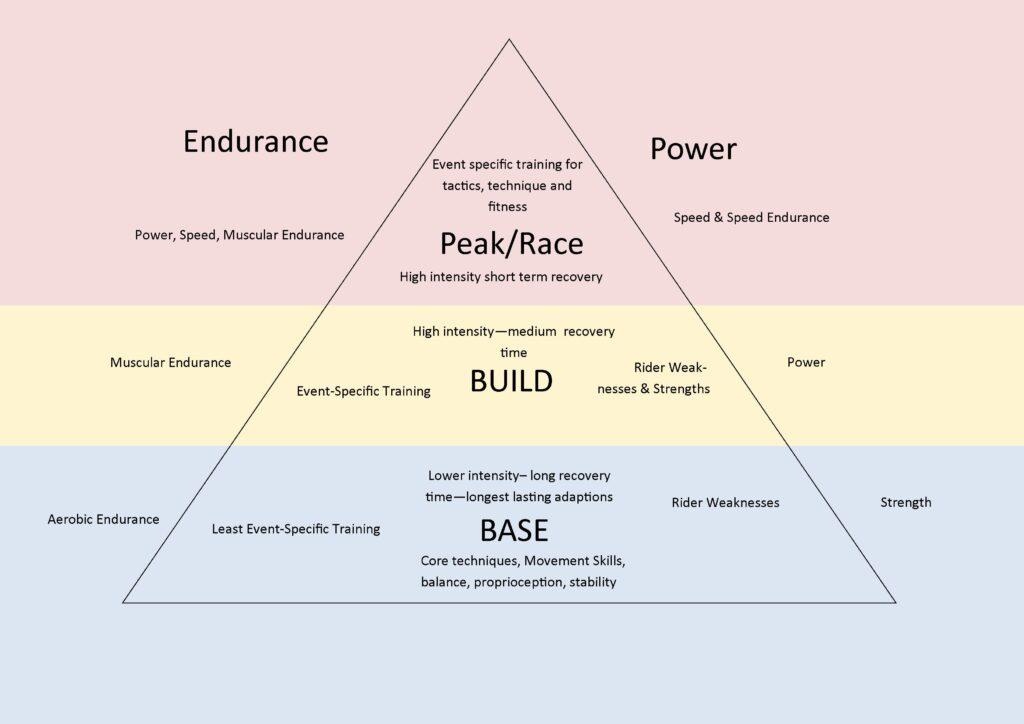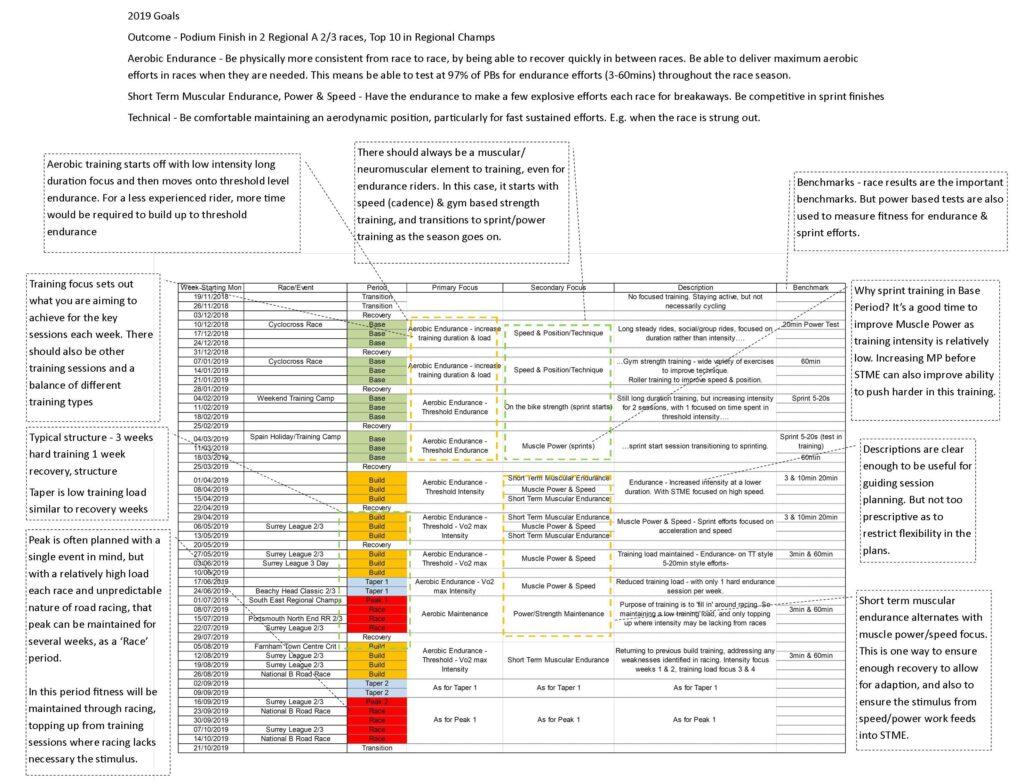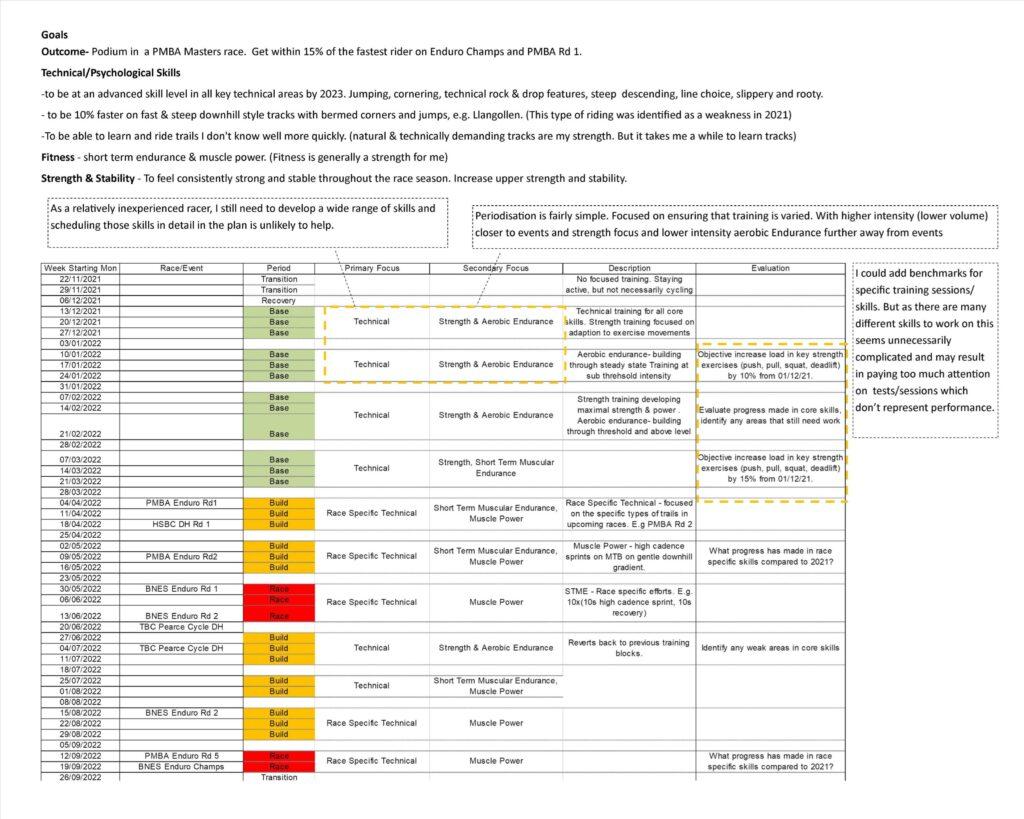10 years of racing and coaching has taught me that the process of writing an annual plan is crucial to achieving results. Over that time, I’ve honed the content and layout of my plans for myself and my coaching clients. I’ll be sharing some key principles in this article.
Writing an annual plan will ensure you think about the key questions, and can make the difference between a goal being achievable or just a distant wish.
An annual plan (or overview plan), is your training plan in its simplest form. It structures objectives in a logical order, so that key gains can be made in time for your target event. It can help to maintain a focus on the bigger picture, serve as a reference guide for session plans and track progress.
There isn’t one way an annual plan should look. I have included two example plans which I wrote for my own training – one focused on road racing and the other for more technical Downhill and Enduro events. These should help you to understand the principles. However, bear in mind they aren’t designed to be a template for any rider.
What are the key steps you should follow?
Goals
Your goal is the outcome(s) you are working towards, typically results in an event. You then need to identify your strengths and weaknesses with respect to the event demands and then write your objectives. For example, a MTB XC rider could be relatively strong in terms of aerobic capacity, but struggle to get a good start due to a lack of power & short term muscular endurance. Both aerobic capacity and power/STME will be training objectives, but they will be scheduled differently.
Calendar
Start by scheduling the significant milestones on your plan: the target event, lower priority events, holidays and commitments that need to be worked around.
Deadlines
Some of your objectives will have deadlines, so these also need to scheduled. For example, if you want to experiment with bike setup and position, this should be done months before your event to allow time to adapt.
Periodisation
This is a way of ensuring your training is varied whilst adding some structure geared towards your event. A bare minimum is seperating race specific training from base training and ensuring your key sessions focus on several distinct objectives. This is an important area so I’ve unpacked this in more detail in the next section.
Periodisation & Variation
This is probably the most complex element of training plans and there is no one right way of periodising training.
Keep it simple. Does your training have variety on a day by day and week by week focus? This is the biggest trap many self-coached riders fall into. They are driven by one training objective which results in making training repetitive. Training with a variety of stimuli keeps it interesting and can help to unlock gains in your key objectives.
Does your planning ensure that you have the right training stimulus leading up to an event, without causing fatigue which impedes performance? If you know what performing ‘fresh’ feels like then this should be fairly obvious. If you have been training hard you will typically need 2-4 weeks of reduced load training in order to recover and perform at your peak.
I’ve summed up the aspects of each typical phase in the diagram below. But you dont need to follow this exactly, and you can mix up Power and Endurance periodisation.

Endurance Riders – Road Race, Time Trial, Track Endurance, Cyclocross & MTB XC
Training for these can all follow the linear endurance training periodisation above. But its also OK to deviate from this and experiment with different structures. The key thing is to distance your most tiring training from the peak event and to make sure your training is varied.
This plan is focused on a few key objectives, specific to my goals for 2019 for MTB XC races. The notes provide more detail about the different elements of the layout and content including: aerobic training, muscular training, sprint training, training focus, structure, peak fitness and benchmarks.

Downhill & Enduro Mountain Biking
These both require a lot of time on the bike to master and maintain skills and they also rely on a level of fitness. For a beginner rider, MTB XC could also be included in this category.
If you have a beginner to intermediate skill level and a reasonable fitness level, then a simple plan will be sufficient. You should always be prioritising technical training until you have achieved a high skill level accross the board. If you are an advanced rider, then your plan will need to have more detail, and specific objectives. At some points in the year you may have to focus much more on fitness than technical training.
These are key questions in writing a useful annual plan for Downhill and Enduro:
What skill level you are starting at and what level you are aiming for?
If you have a lot of progress to make in skills then your training objectives can just be a tick list like this:
-be able to ride all A-line features – Multiple steep/large drops, long jumps, with multiple take off and landing types.
-be able to ride fast & steep corners without braking and within 10% of the speed of the fastest rider.
-be able to ride slippery/rooty natural tracks with minimal braking.
-….etc
The scheduling of training for these objectives wont be particularly important as long as you are working on all of them equally.
If you are a technically more advanced rider, who is not far off the limits of the best riders, then you will need to think more carefully about which skills you need to focus on, and when, in preparation for specific events and to work towards your strengths as a rider.
To what extent are specific fitness gains going to help you achieve your goals?
Unless you have poor fitness which is holding you back in racing. Think carefully about how much focus you put on fitness specific training. As soon as you start on focusing on training which is not on your MTB, you could be drawing precious time away skill development.
Usually there are ways to build specific fitness, whilst maintaining MTB specific skills. For example, if you want to build power and short term endurance. You could do a training session on a Wattbike. Or you could do a sprint intervals session on a BMX track. It will develop pedalling speed/power (accelerating down the start ramp) and short term endurance by pumping with your arms and legs. You will also be developing jumping and berms skills, whilst under physiological strain, similar to racing.
Gym Based Strength Training
Off the bike strength can be useful for all these disciplines. You can develop robustness and stability, reducing injury risk, and enhancing skill and power development. As with endurance training, improving strength can be time-consuming and fatigue-inducing. It can be scheduled in a similar way – planning the training with the highest fatigue furthest in advance of your event.

Summary
I hope that’s got you thinking a bit about planning your season and the potential benefits. Remember the 4 key elements, Goals, Calendar, Deadlines, Periodisation.
Even if you dont feel ready to write a detailed plan, just following some of the steps through can help you to take a more strategic approach to training and racing.
I tailor all plans to individual rider’s needs, strengths, weaknesses and time available. If you have any questions or need some extra support please get in touch or make a comment.

